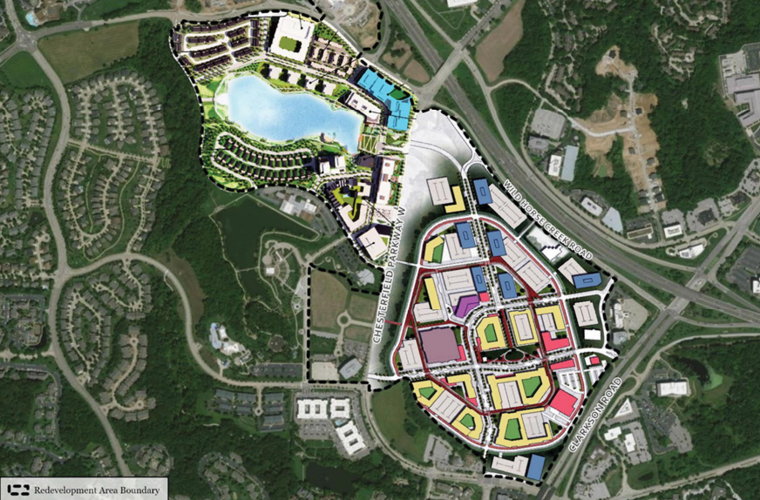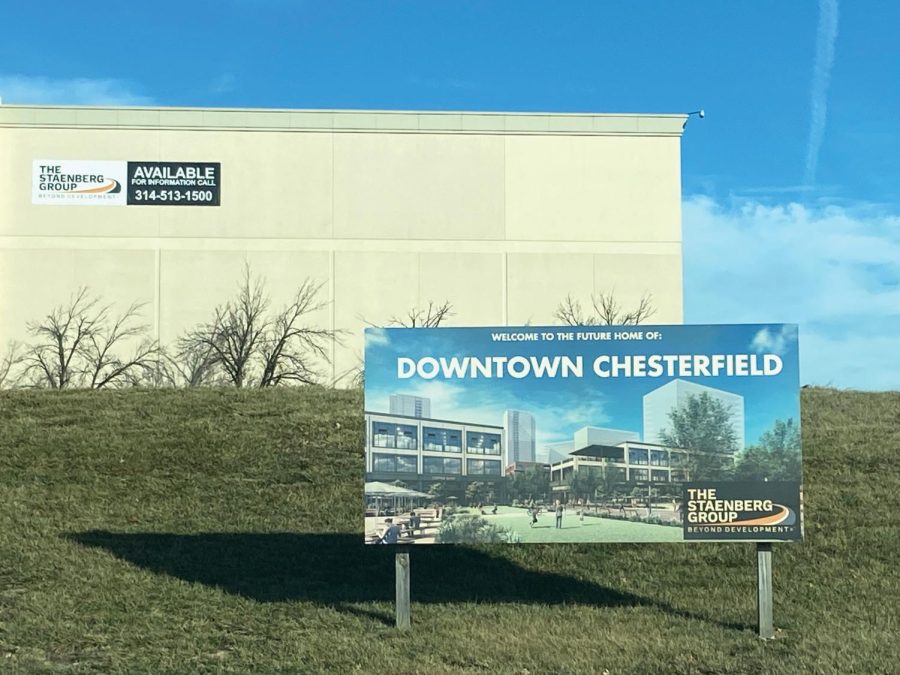CONTROVERSIAL PLAN APPROVED: Chesterfield ‘Redevelopment Zone’ established by county commission
“The future home of Downtown Chesterfield” stands near Chesterfield Parkway.
January 31, 2023
On Dec. 14, Chesterfield city council upheld the recommendation of the TIF commission to create a special economic district. This has far-reaching effects for the city, Parkway Schools and Rockwood Schools.
This story may sound boring, but when you really get down to it, this story is a lot bigger than a new complex, higher property values and even defunding of public schools; this is truly a story of bureaucracy, red tape, and the need for power by different governing bodies.
What is a TIF?
A TIF is a way for municipalities to attract new businesses to the city. It stands for Tax Increment Financing. TIFs temporarily pause tax increases on new developments and allow the city to finance the development based on the amount of tax they will bring in.
For example, Chesterfield Mall is currently assessed at $2 million. Let’s say the tax rate is 10% (its actually a little under 8%, but this is just for easy math). This means currently the city receives $200,000. However, after the property receives a $10 million redevelopment, the mall was reassessed at $20 million. The taxing agencies, city and school district, now receives $2 million. This is the basic principle behind TIFs, but here is where it gets complicated.
In real life, developers don’t have $10 million to put into a project, so the city tries to help them. Typically, in order to get a TIF, developers must prove 1) the property is blighted, overrun by vegetation or rundown, 2) the developer doesn’t have the ability to develop it by themselves and 3) the development is beneficial to the community, either culturally or through property values.
After the developer has proven this, municipalities form a TIF commission. Chesterfield released a statement saying this TIF commission consisted of “Six members from St. Louis County; Three members from cities having a TIF district; Two members from the school districts; and One member from other taxing jurisdictions.”
Now back to how the developer saves money: the TIF commission would decide to freeze the tax on the building at a certain valuation, such as $2 million, despite its increasing value, for 20 years. And the developer will pay the rest of the $20 million to the taxing agencies, but will then get it back in order to fund the project.
For example, if in a year the Chesterfield Mall is assessed at $3 million after renovations have begun, the developer will pay $300,000 dollars to the taxing agencies, but then will be what is basically a refund for the additional $100,000 dollars of tax dollars back to continue to fund the project.
This process of reassessing and refunds continue year over year until the TIF expires.
Effects of TIFs
A TIF has consequences beyond a new development: if it was just the development, these would never get built. Remember the qualifications for a TIF above: the developer has to prove that the development benefits the community as a whole. The development could include more cultural opportunities, higher property values and sales tax, but also defunding education and unequal taxes.
Cultural opportunities are anything that provides a non-monetary value to people, allowing people to connect with the development and use the development beyond making money. These opportunities include nature preserves, landmarks, entertainment venues and infrastructures. This allows the city to host tourists and festivals allowing the citizens to further connect with their city.
Cultural opportunities can also be things that people pay for that are for enjoyment. These can include luxury shopping dining and entertainment which make the city more desirable to live in and visit.
The Chesterfield TIF would support the $3 billion development of “Downtown Chesterfield,” a project by the Staenberg group that would redevelop the Chesterfield Mall and develop the land across Chesterfield Parkway to become a housing complex.
Chesterfield City Administrator Mike Geisel discussed similar projects that citizens can look at to get an idea of the future plans for the development.
“This is a high-end, mixed-use development,“ Geisel said. “We’ve identified four, similar developments. Two of them are immediately adjacent, you’ve got the Park Apartments, you’ve got The Pearl, which houses the Ruth Chris Steakhouse.“
The increased cultural opportunities will lead to higher sales tax income for the city. More shops and restaurants mean more dollars for the city than if the development didn’t exist. This allows the city to reinvest in the city and make the city more desirable.
Another benefit of TIFs is higher property values. As a city adds more cultural opportunities and further develops the city, a city will become more desirable. A more desirable city will have higher property values, which is great for homeowners when they want to sell although it means higher property taxes for those who don’t.
However, the downsides oftentimes outweigh the benefits.

Parkway including the Sachs Library and YMCA up to Wild Horse Creek Road. (City of Chesterfield.)
Chesterfield TIF’s impact on schools
The Chesterfield TIF faced harsh criticism over its effect on schools.
The development is going to provide housing, which is somewhat unprecedented for the use of TIFs. People who live in one of these newly built housing units will not have to pay as much in taxes as other residents of Chesterfield and Parkway.
Parkway’s tax loss on these new residents is especially bad since they have to school the new residents. Parkway spends approximately $15,500 per student per year to school them. Regardless of how much tax or if they pay tax,, Parkway must educate the students living in the district.
Before addressing the loss of tax revenue, which is calculated by the number of new students multiplied by the $15,500 per student, we have to find the number of new students. The estimated number of students brought into the district widely differs depending on the source. Parkway calculated 800 new residents whereas the city of Chesterfield has calculated 300 new residents.
Parkway School District Communications Coordinator Cathy Kelly explained Parkway’s calculations.
“Our CFO and Director of Finance most likely came up with the numbers. For new developments, Parkway will generally use the number of one student per every four households,” said Kelly.
The city used another means of calculation. They looked at four comparable developments and calculated an average ratio.
“[We calculated] a student generation ratio of one student for every 100 [new residences]. And we could say it was up to one of 300. From actual ratios, if you use those four, it’s actually much less than that”, Geisel said. ”Parkway, on the other hand, has a generic 0.25 factor, which is what they use for residential developments. It doesn’t matter if it’s single-family homes, multi-family homes, apartments, condos, or whatever type of development. They say every resident will generate 0.25 students. So they offer no background, nothing on that.”
Remember the second half of this quote comes later is important to see how public agencies exert power over each other and how politics work.
PCH Corral attempted to further investigate and develop our own ratio, but there is a lack of information about this particular development and the demographics of its residents, meaning it is impossible for us to be comfortable calculating a ratio.
The city has a calculated total loss for the Parkway of $4.6 million, whereas Parkway calculated the loss at $12.4 million. However, this does not account for other effects on schools and where the new students would attend school.
“I think the first concern would be Shenandoah Valley just because it’s much smaller than the middle school in high school, They could look at a variety of things. Do they have to change boundary lines? There are a lot of different things that could happen. And also when it’s going to happen,” said Kelley.
There are other issues that could arise too. Parkway has mentioned being forced to remove the voluntary rollback or increase the tax rate to support the additional students for all taxpayers.
Capacity could lead to the use of portable classrooms aka trailers at Shenandoah Valley in the interim or even the eventual construction of new schools.
TIF highlights Governmental Power Struggle
Both agencies, Parkway and Chesterfield, have said they have a strong relationship.
“I just do want to make it very clear that just because we disagree, that doesn’t damage our relationship,”/ m Geisel said. “We still value our partnership with school districts very, very highly,”
“We’ve always had a really good relationship and partnership with the City of Chesterfield,” Kelley said. “We just want to work closely with them and monitor the development and hope they can keep us up to date on the size of the homes, townhouses or condos. At this point, they had not been able to share that information,”
With the commission’s approval, the damage was already done. Partners have split for a lot less than $200 million. The devil here, is in the lack of details. Parkway claims the City has provided little information on the housing. And the city said that Parkway has been too generic with their calculations.
Chesterfield, despite claiming otherwise, has pinned itself against Parkway, by being intentionally vague, they have forced Parkway into a corner. They have attacked them for not being educated, while they have hidden information from Parkway. Or perhaps, they just don’t have enough information to provide.




